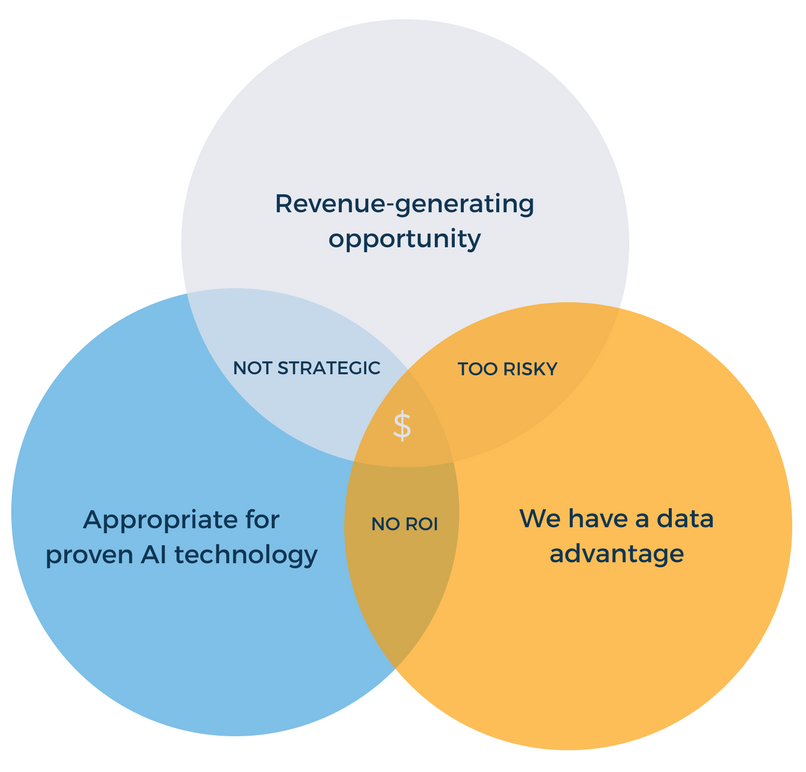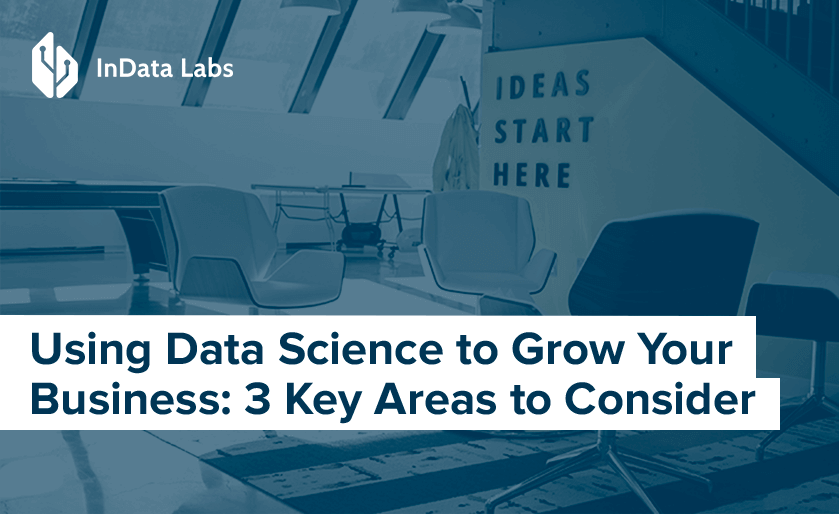Many companies are taking advantage of the latest AI and machine learning technologies to create better products and services. If you consider joining their ranks of successful machine learning projects, you are wise to do so. However, before diving into a new machine learning project you need to make sure that you have identified the best opportunity for your company.
Here are three criteria that will help you check if your idea is worth the investment:

1. Can machine learning generate revenue?
Machine learning projects, like any other business investment, should contribute positively to the bottom line.
To understand how a machine learning (ML) project can do that, you and your team need to answer the following question: how can our ML system enhance the end user experience of our product or service?

Source: Unsplash
It can be useful to think about what real-life problems your customers might experience and match them to the ML problems you are capable of solving. When the realistic use case is found, think about a monetization model for the new functionality. Are users willing to pay for it? Will the new functionality increase average revenue per user and total revenue?
If you think about a machine learning project that promises to create greater business process efficiencies, there is no need to build your own machine learning system from scratch, consider buying an AI solution from a vendor. In most cases, you’ll be able to find a market-proven solution for your specific problem that will save you both time and money. For example, if you want to bring a chatbot into your e-commerce store, you can do it within minutes thanks to companies like Morph.ai, Botcommerce.io, Letsclap.io.
‘Your best machine learning projects should bring you additional revenue — these are the solutions you must own.’ – Kevin Dewalt
2. Can you use existing, proven technology?
Big companies like Google and Amazon are making significant breakthroughs in the field of AI and machine learning all the time, and they are making it publicly available. With Google Cloud’s AI, you can get access to modern machine learning services, with pre-trained models and a service where you can create your own tailored models. Amazon also provides a diverse selection of pre-trained services for automatic speech recognition, natural language understanding, and image recognition.
Building new models based on existing, pre-trained algorithms is a popular concept called transfer learning. It entails building innovative AI products by leveraging APIs from others in the industry.
In other words, there is no need for you to spend your budget developing something that is already out there. You don’t have to reinvent the wheel, just make a better use case for the proven technology… and let the big players spend big money on R&D and make fundamental advances in AI.
3. Can your internal data support it?
Generally speaking, there are three things that can enhance the performance of AI: faster computers, better algorithms, and better training data. The first two are widely available in the market through the development of GPUs and publicly available APIs from big players like Google, Facebook, and Amazon. The same applies to publicly available data.
Both you and your competitors can take advantage of these tools to build better, more complex models, which means that only proprietary training data can provide an ongoing competitive advantage.
Acquiring enough good quality data has always been one of the biggest issues in machine learning. Training data can get expensive because it often takes many hours of expert work to properly label it. As a result, many companies lean on existing training data that is available online. That is useful but only in combination with your own data. Keep that in mind when answering this question.
What’s Next
When your idea meets all the machine learning criteria above, you can dive deeper into your project, thinking about key aspects of your ML system. If you don’t have people with machine learning experience within your company you should also think about selecting a machine learning consulting and development company that will help you turn your most innovative ideas into reality.
I hope this article was helpful for you and wish you good luck with your future machine learning projects.

Source: Unsplash
Where can machine learning be used?
Nowadays, ML gives unseen options by means of data analysis utilizing various learning methods. One of the principal strengths of ML is data analysis-based prediction. The scope of ML usage is extensive and includes but is not limited to the following:
- Natural Language Processing and Speech Recognition;
- Image Recognition;
- Voice Recognition;
- Prediction;
- Social Media;
- Fraud detection.
Machine learning powers have long been an indispensable part of our day-to-day lives.
For instance, Machine learning projects in agriculture help revamp agriculture business activities via technology or gives a more tricked user experience in entertainment. The capabilities of ML are vast. So, let’s investigate some of the machine learning success stories.
What is the result of successfully applying machine learning?
ML algorithms are practiced via Big data enabling the “engine” to discover and pinpoint patterns and issues. Machine learning algorithms can recognize patterns based on prior data.
In this way, ML can find insights based on previous experience. In fact, some of the functions we are used to are now made possible thanks to machine learning.
Likewise, we may not understand ML is behind this or that function when we use it. So let’s dive deeper into machine learning success stories operated daily.
Virtual assistants
Do you know that Alexa is backed by ML? Alexa, Siri, and Google Now are successful machine-learning applications firmly integrated into our daily lives.
You have probably used virtual assistants, so it would be redundant to mention how they work. However, speaking in terms of ML, the method is as follows, and The machine learning techniques listed below are employed:
- Speech recognition;
- Conversion of speech to text;
- Natural Language Processing;
- Text-to-speech conversion.

Source: Unsplash
Machine translation
Remember the days of paper phrase books and dictionaries? Now the inconvenience of paper ones has been replaced by the fast and extremely handy Google Translator. But did you realize that machine learning was also employed to invent it?
Google Translate and similar tools use natural language processing to get an instant translation of a word, phrase, or text.
Social media
As for social networks, they have long been actively using the latest technology, including machine learning. Functions on social networks founded on ML.

Source: Unsplash
The feed and advertising
The development of social media feeds and ads makes use of machine learning.
Thanks to ML, it is now possible to customize feeds and ads based on user interests. For example, a feed of short videos on TikTok, advertising on Instagram, and suggested videos on youtube.
Recommender systems
They are algorithms used to recommend content to users based on their past behaviors and interests. By analyzing user activity and preferences, social networks can make intelligent suggestions to users on what content to view, share, and engage with.

Source: Unsplash
For example, Facebook uses its proprietary algorithm, EdgeRank, to recommend content to users pivoting on their previous interactions. EdgeRank uses a variety of factors, such as time spent on the platform, type of content, and user interactions and engagements, to determine which content is most relevant for each user. Similarly, Twitter and Instagram have their own algorithms for suggesting content. Twitter’s recommender is called Credible and Instagram’s one is Explore.
The “people you may know” feature. Machine learning can recommend accounts of people you know based on subscriptions, friends, interactions with other accounts, shared interests, etc. Machine learning algorithms operate experiential insights, i.e., they analyze users’ behavior-related data and make recommendations based on the results.
Self-driving cars
One of the most striking innovations of the modern world is self-driving cars. Tesla is one of the successful machine learning projects. The artificial intelligence that powers self-driving is built on an unsupervised learning algorithm. The model runs on deep learning and collects data from all cars and their drivers.
Streaming services
Machine learning is also used in the development of streaming services. One of the most evident successful machine learning projects is the mainstream video streaming service Netflix.

Source: Unsplash
Using ML extensively has made its service so fulfilling for its users. Based on the data collected for each individual user, the platform suggests the most engaging content for the user to watch.
Success prediction
Thanks to ML, film directors don’t have to listen to critics’ opinions, which may be subjective and not supported by data, to predict the success of a movie. It’s not the same with machine learning. The data rules the game.
By collecting data on the factors that influence the success of a film, Movie Success Prediction using machine learning has become more precise and data-based. Having a more precise prognosis of the film’s success could lead to a multimillion-dollar box office of the movie.
The same may be true for predicting startup success with machine learning. By piling data from similar failed and blooming startups, one gets data-powered predictions related to a venture to be started.
Fraud detection
Fraud detection is one of the most prominent uses of machine learning. Based on information from prior transactions, ML models analyze a person’s transactional behavior and monitor changes to a pattern.

Source: Unsplash
The scope of machine learning usage stretches far beyond the list above. It can also bring tremendous benefits to your business as well. If it is beneficial for business, can it generate revenue? Let’s find out.
Machine learning success stories
The introduction of machine learning, which enables computers to learn from data without human input, has significantly altered business practices.
Over the past few years, a variety of industries have seen an increase in the use of artificial intelligence (AI) and machine learning. Machine learning has been applied to address issues ranging from healthcare to transportation. Below are some of the most notable recent machine learning success stories.
Using machine learning in healthcare
In 2022, Researchers at the Yale School of Medicine examined MRI tests from 7,805 U.S. children as part of the Adolescent Brain Cognitive Development (ABCD) study. The goal was to identify biomarkers for Attention Deficit Hyperactivity Disorder (ADHD).
Lin Huang, a post-graduate researcher, and colleagues used the data to build machine-learning models that could help diagnose neurological conditions. Subjects in the study were 7,805 kids aged between 9 to 12, with 1,798 having been diagnosed with ADHD.

Source: Unsplash
Through the statistical analysis, the researchers explored the link of ADHD to the brain volume, white matter integrity, and surface area of the children. The study has achieved a major advance in the potential for diagnosing Attention Deficit Hyperactivity Disorder (ADHD) by means of Magnetic Resonance Imaging (MRI) scans.
Machine learning to fight car accidents
Traffic accidents may be avoided with the aid of deep learning. The Qatar Center for Artificial Intelligence and MIT scientists have created a deep-learning model that forecasts extremely fine-grained maps of accident risk.
Researchers tested the model’s accuracy in predicting accidents using accident data and historical data from road maps, satellite photography, and GPS. The dataset spanned 7,500 square miles in Los Angeles, New York City, Chicago, and Boston.

Source: Unsplash
People may be able to limit the number of visits they make by taking action beforehand if they have access to this information. Thus, thanks to machine learning car crashes may be prevented and human lives are saved.
Why do most ML projects fail?
The machine learning success rate tends to be low. Gartner estimates that 85% of ML efforts fail. Why? There are many possible causes, not just machine learning itself.
Data issues
Data is required to deploy a machine learning-powered project successfully. However, AI project success criteria are not general data but relevant, meaningful, precise, and structured. In addition, machine learning must have barrier-free access to the data, so storing all the data in a single source is preferable.
A problem to be solved isn’t clearly specified
The project’s success is contingent on effectively addressing a specific business issue. The same holds true for machine learning projects.
Therefore, it is essential to ensure that AI and ML are utilized with careful consideration and not merely as a reflexive choice to follow a tendency. If a machine-learning project fails to address a particular problem, then it could be a waste of resources.
Staff lacks knowledge or skills
Despite the availability of online courses, there is still a great demand for skilled and educated machine learning specialists. However, these courses often lack the comprehensive instruction and breadth of Machine Learning techniques required to adequately equip a technician with the necessary expertise to competently carry out the day-to-day duties of a machine learning engineer.
As a result, hiring such an individual without the requisite skill set may result in costly mistakes and a waste of resources. If your experts do not cope with the task set by ML, the silver bullet can be the option to hire a machine learning consulting company.
The contrast between software development and data science
It is erroneous to believe that software development and data science are analogous. Data science is an amalgamation of research and engineering, making it more erratic than software development.
In contrast to the linear progression of software development, the data science process is unpredictable and can loop back to previous stages repeatedly until the specified result is accomplished.
Lack of collaboration between the teams
Machine learning success relies greatly on collaboration between teams engaged in a project. Data engineers, data stewards, BI experts, and Data Scientists must work together with engineers and DevOps with a shared vision and coherence for the desired outcome. When these teams do not collaborate, achieving the criteria for success in AI is made more complex, affecting the end result.
No one can guarantee 100% success in machine learning, but there are steps that can be taken to lessen the likelihood of failure and enhance the chances of success. These include avoiding the common mistakes mentioned above.
As such, Machine learning success rates can be raised by having a solid grasp of the technology, adequate data collection, thorough problem characterization, efficient model selection and evaluation, and fast feedback.
Summing up
Successful machine learning projects are an increasingly popular way of leveraging AI and ML technologies to create better products and services.
To ensure that an ML project is worth the investment, three critical criteria must be taken into account: the ability to generate revenue, the ability to solve real-world problems, and the availability of resources.
Revenue can be generated by providing enhanced user experiences and solving real-life problems through ML. Moreover, resources such as data, skilled personnel, and infrastructure must be readily available. By adhering to these criteria, businesses can ensure a successful and profitable ML project.
Work with InData Labs on your machine learning project
Have a project in mind but need some help implementing it? Drop us a line at info@indatalabs.com, we’d love to discuss how we can work with you.



